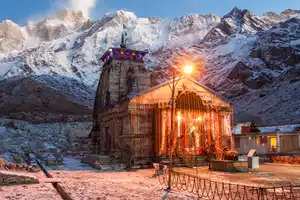History of Kedarnath - The Story Behind This Ancient Temple
Home » Kedarnath Dham »
Kedarnath, a sacred Jyotirlinga and an essential stop on the Char Dham Yatra is located at over 11,000 feet in Uttarakhand’s Himalayas. While its exact date of construction is still unknown, many believe the present structure was revived by Adi Shankaracharya in the 8th century. His efforts aimed to promote spiritual unity and revive the Hindu faith. It is also believed that he attained Mahasamadhi near the temple, where a memorial stands today. There is also a commonly accepted belief that Pandavas had built this temple dedicated to Lord Shiva during their journey to heaven.

Mythological Legends
Primarily there are two of the most widely accepted history regarding the creation of the temple which are:
Pandavas and Lord Shiva:
After the great war of Kurukshetra popularly known as Mahabharat, the Pandavas were burdened by guilt for killing their kin, the Kauravas. On the advice of Sage Vyas, they sought forgiveness from Lord Shiva for their sins. Their journey began in Kashi, but upon learning that the Lord resides in the mighty Himalayas, they traveled to Kedarnath with Draupadi.
However, Lord Shiva, displeased and unwilling to grant forgiveness immediately, disguised himself as a bull and hid among a herd in Guptkashi. Nakul and Sahadev noticed a unique-looking buffalo, which began sinking into the ground when identified. Bhim, the strongest of all the Pandavas, grabbed a hold of the bull’s tail and started to pull it outwards. The Lord then finally emerged in front of the Pandavas and granted them their wish and absolved them of their sins.
Later, on their journey to heaven, the Pandavas built five temples at significant spots to honor lord Shiva. These came to be known as Panch Kedar and include– Tungnath, Rudranath, Madhyamaheshwar, Kalpeshwar, and Kedarnath.
Nar and Narayan’s Penance:
Another legend revolves around the two incarnations of Lord Vishnu Nar and Narayan. These two twins performed rigorous penance to Lord Shiv in front of a lingam which they had fashioned out of some mud at Bharat Khand in Badrikashram. Lord Shiv became extremely pleased with their hard penance and appeared before them to give them a boon. The sages humbly requested the Lord to reside permanently at Kedarnath in the form of a Jyotirlinga. Granting their wish, Lord Shiva manifested himself as a linga, and the temple was later built over it. Since then, Kedarnath has been a hotspot for spiritual and religious activities.
Scientific Insights
Scientific studies suggest the Kedarnath temple survived a mini-ice age between the 13th and 17th centuries. During this period, it remained buried under thick layers of ice for nearly 400 years. Remarkably, the structure endured with minimal damage. According to experts from the Wadia Institute of Himalayan Geology, the temple’s survival is due to its robust construction using large, interlocking mountain rocks. Once the ice receded, it left visible marks on the temple walls, further confirming its resilience.
Conclusion
Kedarnath is not just a sacred temple but it is a hub of faith, endurance, and divine presence. With deep roots in mythology and history, this temple continues to inspire millions of devotees and explorers to visit there. This temple will surely offer you a sacred experience that exceeds belief and touches the soul. When are you planning your trip to Kedarnath then?


Leave a Reply